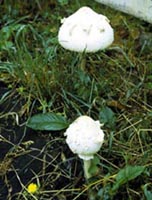Resource Library
Plant of the Week: Mushroom, Death Angel (Destroying Angel)
The University of Arkansas System Division of Agriculture does not promote, support or recommend plants featured in "Plant of the Week." Please consult your local Extension office for plants suitable for your region.
Plant of the Week
Death Angel, Destroying Angel
Latin: Amanita sp.

The heavy rains experienced across much of Arkansas in the last few weeks should have the mushrooms popping up like toadstools, so the saying goes.
One of the most common of these is likely to be the mushroom given the well-deserved and ominous names of Destroying Angel or Death Angel (Amanita sp.). While biologists no longer consider fungi to be plants, assigning them instead to their own kingdom, I will do a bit of fence jumping and bring them into our general discussions.
The Death Angel is the large white mushroom that appears in late spring and summer in the woods, in cleared fields or in home lawns wherever an adequate supply of buried organic matter is found. By common usage, the inedible and poisonous types are usually referred to as toadstools, but to mycologists they are all mushrooms. Fungi such as the Death Angel are soil-inhabiting saprophytes that make a living by enzymatically digesting plant debris.
When the filamentous strands (called the mycelium) have accumulated enough food reserves and the environment is just right, one or more mushrooms will appear suddenly. The Death Angel mushroom is usually 6 to 8inches tall with the cap expanding to 5or 6inches in diameter. The color is whitish, sometimes tinged with brown, sometimes with a bit of gray. The color changes as the mushroom ages. Below the gills on the stout stem will be a filamentous skirt. If the mushroom is dug, a golf ball-size mass of mycelium will be found at the base of each mushroom.
There are probably about six species of Amanita found in North America and these are responsible for 95 percent of the cases of mushroom related fatalities that occur in the United States. But, the number of actual fatalities is really quite low. Between 1985 and 1996, 14 fatalities were reported in more than 85,000 exposures. In 1991, the worst year during this period, three fatalities were reported.
Children are the most susceptible because their smaller body weight results in a higher dosage of the toxin.
The economic upheaval that beset Russia in the mid-1990's left much of the population dependant on their small garden plots for the bulk of their food. Not surprisingly, many Russians began to supplement their beets, cabbages and potatoes with wild mushrooms. However, mushrooming expertise was sorely lacking amongst many would-be hunters. In 1997, at least 34 people died from mushroom poisoning. As economic conditions improved and the word spread, only seven people died the next year.
The poison responsible for the fatalities is a pair of peptides called amatoxins that work by inhibiting protein synthesis. Initial symptoms occur in six to eight hours after eating the mushroom and begin with severe stomach cramps, diarrhea and vomiting. These symptoms soon pass, but within 48 hours the toxins begin doing extreme damage to the liver and kidney. In 1988 a Korean immigrant living in Washington State accidentally fed her family Death Angel mushrooms. The family survived, but four of the five had to undergo liver transplants.
Over the years I have gotten a surprising number of questions to help determine if a particular mushroom is edible. I always decline the invitation. While the number of fatalities is low and the Death Angels are relatively easy to identify, I always urge caution.
Unless you collect mushrooms with someone who knows what they are doing, I would limit my foraging to the local farmers market or grocery store. The old adage, "There are old mushroom hunters, but there are no old, bold mushroom hunters" seems appropriate.
By: Gerald Klingaman, retired
Extension Horticulturist - Ornamentals
Extension News - May 23, 2003
The University of Arkansas System Division of Agriculture does not maintain lists of retail outlets where these plants can be purchased. Please check your local nursery or other retail outlets to ask about the availability of these plants for your growing area.